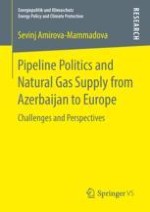Sevinj Amirova-Mammadova explores pipeline dynamics and natural gas supply within the southern gas corridor and provides an analysis of how policy interests and decisions of the state actors affect the current energy politics in the Caspian region. The research period covers the second stage of the Caspian energy development determined by the production and export of natural gas to the European markets. The focal point of the policy analysis lies on the competition among the different pipeline projects, namely NABUCCO, ITGI, TAP, SEEP, and the decision‐making process of the export route selection. Energy interests of Turkey, Russia, and Azerbaijan elaborated in the research explain how and why certain decisions have been made by these major regional actors.
